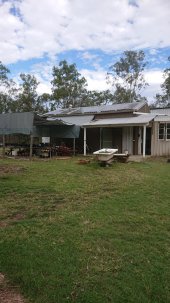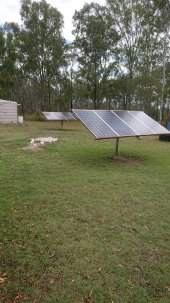Reverse cycle should consume no more wattage than cooling cycle.Air con is still running great. Can't really use the reverse cycle for heat. The amount of power it draws is unreal. 80 ahr's + I'm sure it would settle down after a while but think it would still be too high to use. Here are a couple of photos of my set up
You are using an out of date browser. It may not display this or other websites correctly.
You should upgrade or use an alternative browser.
You should upgrade or use an alternative browser.
House air conditioning on stand alone power
- Thread starter Aussie
- Start date
wattmatters
Solar Wizard
Reverse cycle should consume no more wattage than cooling cycle.
Efficiency of RCAC for heating and cooling cycles are quite different though, impacted by the quality of the unit, the type of phase change material used, the climate and weather conditions, e.g. a compressor unit needing to engage defrost mode reduces heating efficiency a lot. Will depend somewhat on where Aussie is located.
Aussie has bought Mitsubishi Heavy Industries units, which are about as good as you can get for robustness/reliability.
Lithium Iron Phosphate chemistry batteries.What are these LiFePO4's? Not aware of them.
They have much greater energy density than lead acid, can be cycled to a much greater depth of discharge without damage, have much greater cycle life with this DOD, can be charged more quickly, don't mind being left at partial charge state for long periods and require little to no maintenance provided you use a good battery management system. They are more expensive (especially in Australia) but over a lifetime now provide about the same cost or better per kWh throughput for home storage use compared with lead acid.
When you finally get to the end of life of your current bank, you may wish to consider swapping over to the newer chemistry. Lead acid still has its place and applications. I use LA as a backup power bank and so don't cycle them, hence cycle count isn't a relevant factor. It would be way more expensive to use LiFePO4 for that application (about triple the cost for me).
wattmatters
Solar Wizard
It may be it operates a "boost" cycle on start up. You may be able to disable that.Can't really use the reverse cycle for heat. The amount of power it draws is unreal. 80 ahr's + I'm sure it would settle down after a while but think it would still be too high to use.
They also have an economy mode which tends to reduce peak power draw.
Aussie
New Member
It has been cold , 10 cel , maybe. Set temp at 20 cel. When I saw what it was drawing I discontinued use. I may try again and check out that boost function. The most I have seen with A/C is less than 60 amp hrs. And it goes down soon enough. Thanks for the " heads up"on the boost , and info on LiFePO4 batterys,
wattmatters.
wattmatters.
Aussie
New Member
If I change over to LiFePO4 battery's, What Items in my present system will I need to change for the new batttery's?
wattmatters
Solar Wizard
I'll leave that to the experts in building LiPo batteries but you'll need to have battery management / charge controller system suited to LiPo.If I change over to LiFePO4 battery's, What Items in my present system will I need to change for the new batttery's?
Aussie
New Member
You say "building LiPo batterys". Not sure what you mean by that.I'll leave that to the experts in building LiPo batteries but you'll need to have battery management / charge controller system suited to LiPo.
Hedges
I See Electromagnetic Fields!
- Joined
- Mar 28, 2020
- Messages
- 20,809
A real concern is putting to many amps into my batterys and having them dry out and having a short life. They cost me $15000.
The batterys are VRLA Tubular gel
Since you have them, it would be reasonable to use them (properly) for the duration of their natural life, consider LiFePO4 in the future as a replacement.
Your batteries will have a preferred charge rate. What is it?
Ideally your system will deliver exactly that current to the batteries, and also power your A/C, with PV producing more than enough for both. Batteries cost more than PV, so wasting unused production is reasonable. Orienting some panels for morning sun and some for evening would level production, fit usage better.
A typical system with charge controller and inverter that don't talk to each other can't do that. Victron can, because it has a battery shunt that is monitored, and SCC is given instructions. Probably most hybrids can, because it is built in. AC coupled systems like SMA can, because the battery inverter sets charge current and controls AC coupled PV inverters.
Alternatively if you switch to LiFePO4, it doesn't care what charge rate so long as not excessive. Typically up to 0.5C at room temperature, but the rate has to be reduced approaching 0 degrees C (that is the cutoff), also approaching max temperature. It doesn't care if kept partially charged, prefers maybe 95% or less.
Hedges
I See Electromagnetic Fields!
- Joined
- Mar 28, 2020
- Messages
- 20,809
You say "building LiPo batterys". Not sure what you mean by that.
You can buy 'em, but you'll spend as much per kWh of cycle life as for VRLA lead-acid.
"B" grade LiFePO4 cells from China, plus a BMS, and you can DIY for 40% the purchase price of VRLA, and maybe get 5x the cycle life.
The hobby is in its infancy, people are making mistakes, but they are also doing it successfully.
These days it is 280 Ah 3.4V cells for about $100 each. BMS (cell level monitoring, balancing, and disconnect) is a few hundred depending on brand and capability.
wattmatters
Solar Wizard
LiPo being shorthand for LiFePO4.You say "building LiPo batterys". Not sure what you mean by that.
Building a battery in the same way your existing battery built - by connected a whole set of individual battery units together in an appropriate configuration to supply the desired voltage and Ah rating.
Watch some of Will Prowse's videos on building a battery system to see what I mean.
Aussie
New Member
The panels on the shed are fixed, facing north.These are the 80 watt panels. The post mounted panels are my 200 watt panels. I can rotate to get early morning sun and late afternoon sun. I run 240v power from the shed to the house.
Attachments
wattmatters
Solar Wizard
These days it is 280 Ah 3.4V cells for about $100 each.
16 * 280Ah LiPo cells (~14.3kWh) landed in Australia will set you back around A$3k. For good battery life (3000+ cycles) consider that ~10kWh useable capacity.
You currently have 49.2kWh of lead acid which provides ~24kWh useable capacity. So you can see an equivalent bank of LiPo is going to be approximately $7-8k. But that's just the cells - not the controller systems and you have to put it all together which needs some hardware.
It's possible to buy pre-built battery packs with all this stuff built in but they are much more expensive.
Assuming your existing batteries are good, then they can provide you with good service life and you can look at swapping out to newer tech when the time comes.
Hedges
I See Electromagnetic Fields!
- Joined
- Mar 28, 2020
- Messages
- 20,809
If an air conditioner has "LRA", locked rotor amps rating, the inverter has to deliver that for about a second (surge rating).
Without LRA, multiply nameplate amps by 5x to get an estimate of what is needed for surge.
If you get an inverter drive A/C (has 3-phase motor and inverter that slowly ramps up), could be no surge so only need inverter continuous wattage higher than rated amps of A/C, fan, etc.
Note that VA, volts x amps, is often higher than "watts" or real power.
Without LRA, multiply nameplate amps by 5x to get an estimate of what is needed for surge.
If you get an inverter drive A/C (has 3-phase motor and inverter that slowly ramps up), could be no surge so only need inverter continuous wattage higher than rated amps of A/C, fan, etc.
Note that VA, volts x amps, is often higher than "watts" or real power.
Aussie
New Member
My air con is an inverter type. Single phase, 240vIf an air conditioner has "LRA", locked rotor amps rating, the inverter has to deliver that for about a second (surge rating).
Without LRA, multiply nameplate amps by 5x to get an estimate of what is needed for surge.
If you get an inverter drive A/C (has 3-phase motor and inverter that slowly ramps up), could be no surge so only need inverter continuous wattage higher than rated amps of A/C, fan, etc.
Note that VA, volts x amps, is often higher than "watts" or real power.
Aussie
New Member
wattmatters: I am just considering my next batterys. My present batterys are made in china and I have my fingers crossed on their quality. I have had 4 years out of them so far.
wattmatters
Solar Wizard
Well managed you should get many more years and by then LiPo should be a bit cheaper too! Good luck with it all.wattmatters: I am just considering my next batterys. My present batterys are made in china and I have my fingers crossed on their quality. I have had 4 years out of them so far.
LiPo being shorthand for LiFePO4.
Let's not do that. LiPo is used to indicate Lithium Polymer. Use LFP if you want to short-hand LiFePO4.
Kind of hypocritical to complain
If you look at the current use of the terms, it's pretty confusing and potentially dangerous to mix LiPo for use with LiFePO4. Additionally, I personally dislike the term LFP, and I would recommend using LiFePO4 since then there is no confusion.
wattmatters
Solar Wizard
OK. Put it down to tired fingers.Let's not do that.
Similar threads
- Replies
- 1
- Views
- 80
- Replies
- 2
- Views
- 301
- Replies
- 11
- Views
- 469
- Replies
- 10
- Views
- 489
- Replies
- 106
- Views
- 3K




